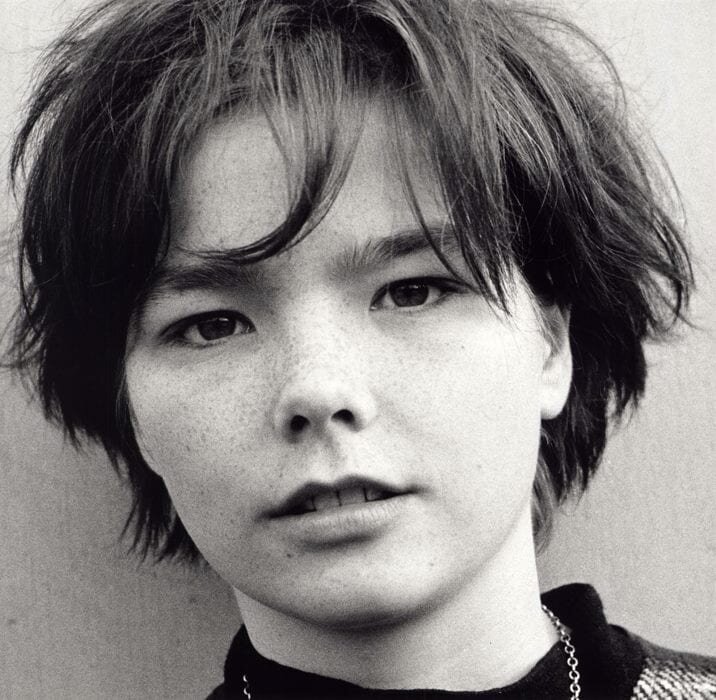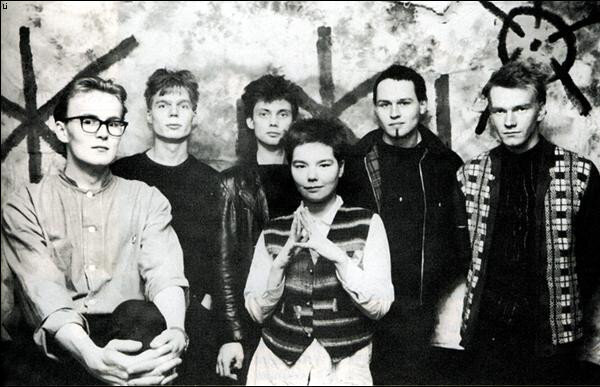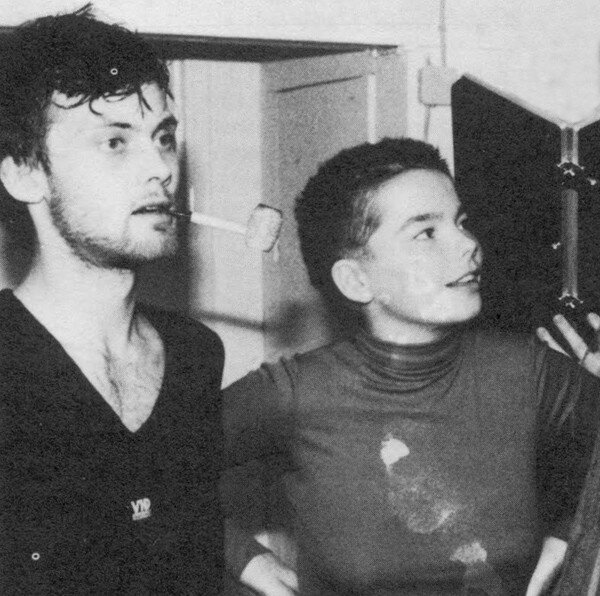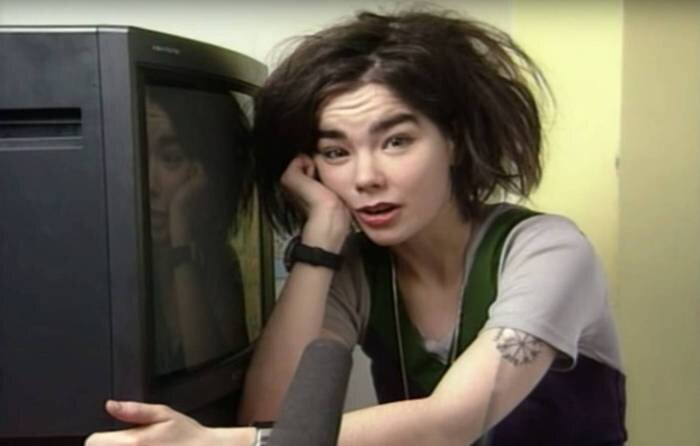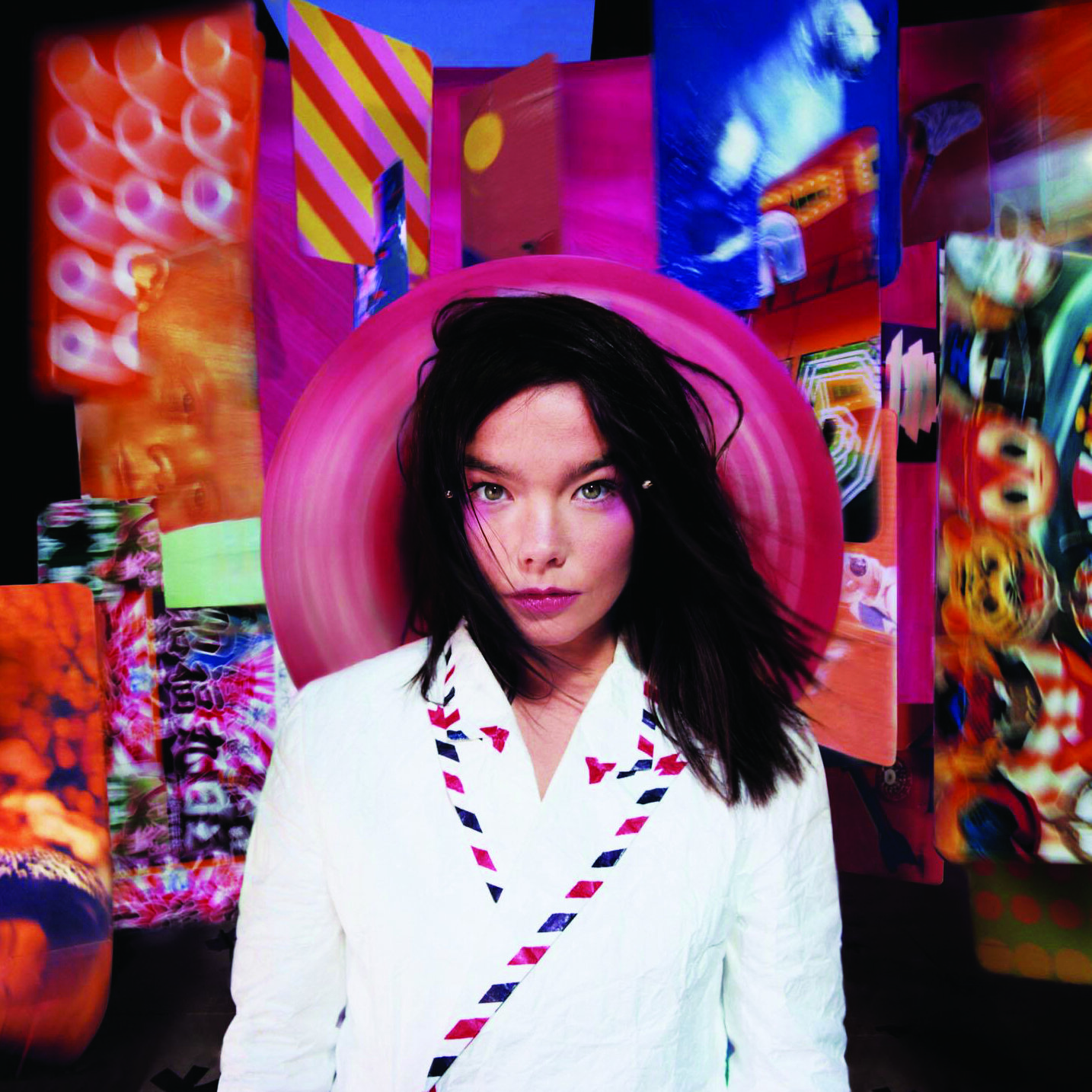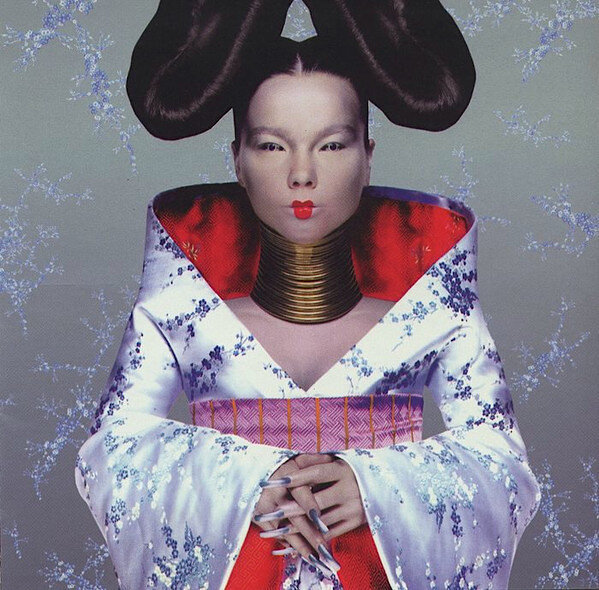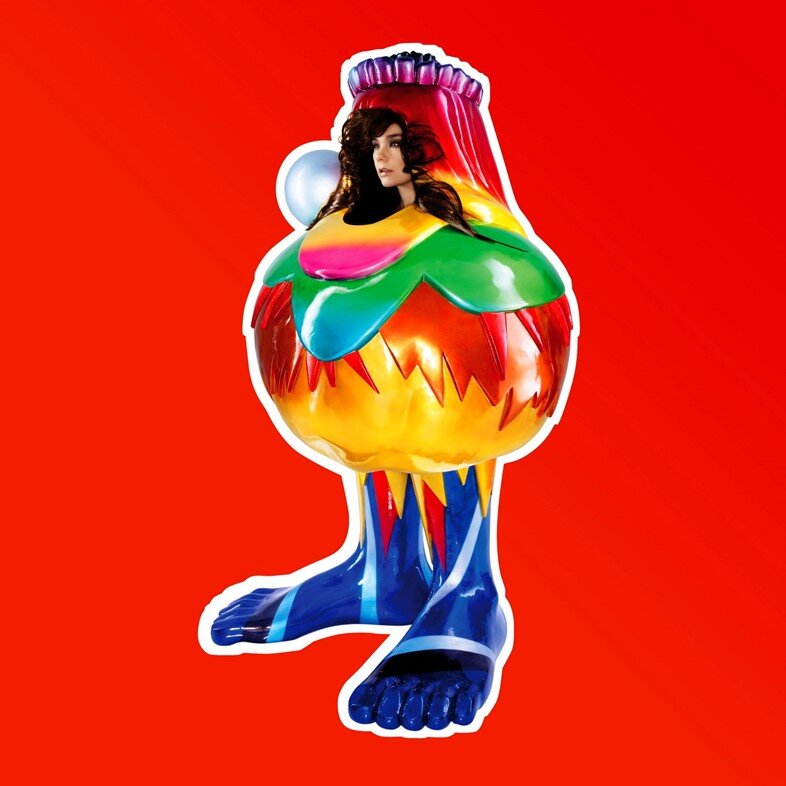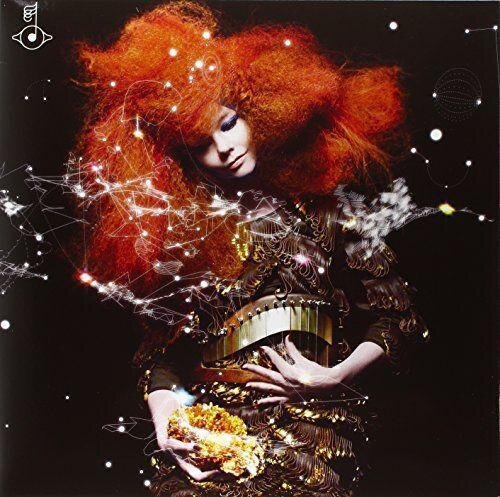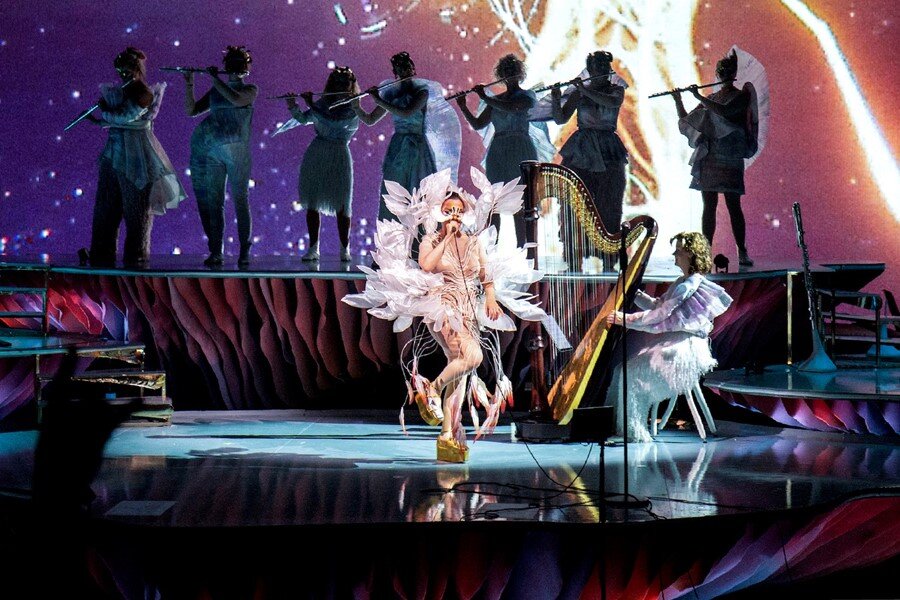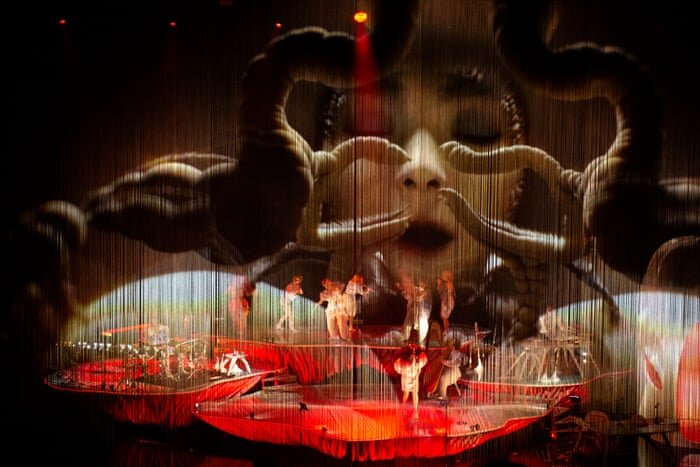Army of Me: A Björk Retrospective
Click below on the streaming service of your choice to listen to the playlist as your read along.
In the summer of 1988 I was eighteen and, with a summer job, a driver’s license, and increasing independence, enjoying the long summer nights with friends. It was a bleak period for modern rock and I found myself listening more to classic rock. However, an exception was one of my top obsessions that summer, the album Life’s Too Good by The Sugarcubes. The album introduced me to the incredible talent of Björk Guðmundsdóttir*, starting a ten-year span when her voice was one of the most frequent sounds on my stereo.
*A quick note about the Icelandic naming conventions since we’ll see a lot of them in this profile. They do not use surnames the way western nations do for family lineage. Instead, they have a given name followed by a reference to their father’s given name (or, less frequently, the mother’s) with the suffix, ‘son,’ for boys, and for girls, ‘dóttir’ (‘daughter of’). Thus, Björk’s surname is taken from her birth father, Guðmundur Gunnarsson.
It wouldn’t be long before a larger audience came to know Björk as she became one of the most fascinating, celebrated, respected, and newsworthy icons of the music world. She is undoubtedly one of, if not the, most famous Icelander ever and her success has helped her small island nation become a new and unlikely focal point for new music.
Björk’s undeniable talent, creativity, and personality gave her performing career an early start. Her hometown of Reykjavík had a vibrant cultural community, with exposure to music from other Scandinavian and northern European countries, not the least of which the UK. Her parents split just after she was born and she grew up on a commune with her mother, an environmental activist, and stepfather, Sævar Árnason, who played guitar in a band. Given these influences and experiences, combined with the harsh, isolated beauty of Iceland, the seeds of Björk’s solitary and forceful creative spirit were evident.
Ann 11 year-old Björk performs on Icelandic television
At age six, Björk began attending Barnamúsíkskóli, Reykjavík’s College of Music. After the country’s only radio station played a recording of her singing a school performance of the Tina Charles’ hit, “I Love to Love,” Björk was given the chance to record an album. She released her first LP, Björk, in 1977, just after her twelfth birthday. It was mostly covers of Icelandic songs though did include some songs from the likes of The Beatles, Edgar Winter, and American singer, Melanie. One song was written by her stepfather and there was one original composition, “Jóhannes Kjarval.” All the songs were sung in her native language and the album’s success made Björk a celebrity across Iceland, which made her uncomfortable.
The Playlist
Hrollur
Assassin
Síðasta Ég
Birthday
Coldsweat
Blue Eyed Pop
Regina
Dream T.V.
The Bee
Luktar-Gvendur
Ooops
Hit
Walkabout
Hetero Scum
Human Behaviour
Come to Me
Violently Happy
Play Dead
Army of Me
Hyperballad
Enjoy
Isobel
Hunter
Joga
Bachelorette
Alarm Call
New World
Hidden Place
Pagan Poetry
Heirloom
It’s in Our Hands
Pleasure Is All Mine
Who Is It
Earth Intruders
Wanderlust
Náttúra
Thunderbolt
Crystalline
Stonemilker
Quicksand
Arisen My Senses
Blissing Me
Declining to record a second LP, she focused on finishing her schooling and began performing in bands. First, there was an all-girl punk band, Spit and Snot, and then a pop-new wave-jazz act, Exodus, followed by Jam-80, which did punk versions of prog rock songs. It was apparent from the start that Björk was going to follow a meandering musical path. All of these acts were with adults, making her an unusually young participant in the Icelandic music scene.
“Hrollur” \ Rokk í Reykjavík (documentary film) \ Tappi Tíkarrass (1982)
Graduating in 1980 from Barnamúsíkskóli and now aged fourteen, Björk and Jam-80 changed direction to begin writing and performing original punk and post-punk material. They renamed themselves in late ’81 to Tappi Tíkarrass, which in English meant, “cork the bitch’s ass.” At first, she shared vocal duties with Eyþór Arnalds before he departed and left her as the sole vocalist.
Tappi Tíkarrass first released an EP, Bitið fast í vitið, in 1982 followed by an LP, Miranda, in ’83. The band’s performance in the TV documentary, Rokk í Reykjavík, which became an iconic artefact of the burgeoning alternative music scene in Iceland, along with Björk’s picture on the movie’s cover, elevated both the status of the band and its singer. It also provided some quality footage of the band in action and some of Björk’s earliest performances. She can also be seen performing at the Melarok festival in August 1982, showing how truly young the sixteen year-old Björk looked next to her bandmates.
“Assassin” \ The Eye \ Kukl (1984)
After performing in a collaborative, live session to close out the run of a local radio show, Björk and the other invited musicians from various Icelandic bands decided to continue performing together. They named themselves Kukl (also written as KUKL or K.U.K.L.), which meant ‘witchcraft’ in medieval Icelandic. Vocals were again shared between Björk and a male vocalist, this time Einar Örn Benediktsson. He was attending school in London and had fallen in with its anarcho-punk scene. This led to Kukl making their first live performance in Reykjavík as the openers for Crass, the British art collective and punk band. This relationship paid off when Crass’ drummer, Penny ‘Lapsang’ Rimbaud (Jeremy Ratter) produced Kukl’s first LP, The Eye, and released it in 1984 on their label, Crass Records.
There followed a live LP in 1985 and a second LP in 1986, Holidays in Europe (The Naughy Nought), which was also released on Crass. The Eye was experimental, shifted between noisy and ambient compositions, and ranged through generally dark wave styles. In “Assassin” these elements were apparent as the dark rhythms propelled the song. The second LP was more ambient and avant garde, and played more like a soundtrack than a pop or punk album. During this stint Björk developed her voice further, evolving the pop and punk style she’d employed for Tappi Tíkarrass into a more nuanced and varied style, bringing out more of the yelps, growls, shrieks, and hushed interludes that would come to mark her style.
“Síðasta Ég” \ unreleased (later issued on the B-side to “Big Time Sensuality”) \ The Elgar Sisters
Concurrent to Kukl, Björk and bandmate, guitarist Guðlaugur Kristinn Óttarsson, started a side project under the name, The Elgar Sisters. The duo, accompanied by a variety of guest musicians – some of which were their fellow Kukl band members – recorded eleven songs between 1984 and 1986, most written by Óttarsson. None of the songs were released though both Björk and Guðlaugur would include them in later solo releases.
In 1986, Kukl was facing challenges as a going concern. Einar Örn was back at school in England and Björk had become pregnant from her relationship with, Þór Eldon Jónsson, the guitarist from the band, Medúsa. In this video of a Kukl performance, her pregnancy was quite noticeable. She and Eldon got married and in June 1986 had a son, Sindri Eldon Þórsson.
L to R: Björk in 1985, Kukl, and The Elgar Sisters
“Birthday”; “Coldsweat”; “Blue Eyed Pop” \ Life’s Too Good \ The Sugarcubes (1988)
Einar Örn returned from school in England in pursuit of two new projects. One was the formation of a new record label, Smekkleysa, which would be known as Bad Taste in English, though the literal translation of the Icelandic name was ‘tastelessness’; and the other was getting a new band going after the demise of Kukl.
The new band was dubbed, Sykurmolarnir, or ‘sugar cubes,’ and its first recruits largely came from the Kukl line-up, with Einar on vocals, Sigtryggur "Siggi" Baldursson on drums, and Einar Melax on keyboards. Bragi Ólafsson, who had been in the punk band, Purrkur Pillnikk, with Einar Örn, was added on bass. Friðrik Erlingsson gave them a guitarist, though he was soon replaced with Björk’s husband, who performed as Thór. And though the band came together on the same day she was having her baby, Björk was also on board for vocals.
In 1988, explaining on television, how a television works
Despite two-thirds of the new sextet coming from Kukl, little about The Sugarcubes, as the band would be known in English, bore much resemblance to the sound of its predecessor. The ambient experimentation was mostly abandoned in favour of more straightforward arrangements, building a slightly off-kilter pop sound with tight rhythms and new wave flavoured guitar accents. The most common elements were the distinctive and playful vocal exchanges between Björk and Einor Örn, with her sound coming in high, varied, nuanced, and piercing, while he was prone to irritating rambling and interjections.
Einor’s new label was formed with Ásmundur Jónsson from Gramm Records, which had been the label for all of Tappi Tikarras, Kukl, and Purrkur Pillnikk’s releases. In 1987, Gramm went bankrupt and Ásmundur started working with Einor on starting up Smekkleysa. The label’s first release was The Sugarcubes first 7” single, “Einn Mol'á Mann” (one cube per person). Its B-side had two songs, the Icelandic versions of “Birthday” (“Ammæli”) and “Cat” (“Köttur”), both of which would appear on their first LP. The single didn’t sell well in Iceland. However, Orn’s relationships with the UK punk community resulted in The Sugarcubes being signed to a new British label, One Little Indian Records. It had been formed in 1985 by the bassist of the anarcho-punk band, Flux of Pink Indians. One of its first releases was by A.R. Kane, who would influence the burgeoning shoegaze scene, which, along with electronica, One Little Indian would support through other acts such as Kitchens of Distinction, The Shamen, and Sneaker Pimps. Its biggest acts though would be The Sugarcubes, and later, Björk.
The Sugarcubes first release in the UK was an English version of “Birthday,” issued in August 1987. Its Icelandic version was the B-side. It was a stupendous introduction of the band to UK audiences, with Björk’s incredible vocal performance – arguably the best of her career – growling and soaring over a moody, dark wave sound marked by a loose, crashing drum arrangement. As he had done for so many others, DJ John Peel promoted the single on his show and it caught on, becoming the magazine NME’s ‘single of the week’ shortly after and then #1 on Peel’s annual, ‘Festive Fifty’ year-end list. It reached #1 on the UK Indie singles chart and #65 on the UK singles chart. “Birthday” was the song, in the summer of ’88 when I fell for The Sugarcubes, that I played the most.
Major labels came calling, but the Icelanders’ independent streak resulted in them not signing unless they had complete creative control, which of course the labels would not abide. Therefore, the band set about recording their first album for release through One Little Indian. During that time Einar Melax left the band and Björk took on keyboard duties. They also befriended Howard Thompson, an A&R rep for Elektra Records, and he signed the band to a US distribution deal. Therefore, in April 1988 the band’s debut LP, Life’s Too Good, was released in both the UK and US. It was exposure no prior Icelandic act had ever achieved.
Life’s Too Good lived up to the hype that “Birthday” had engendered. It was an incredible album that mixed catchy pop melodies with dark, swirling rhythms, all flavoured by the differing vocals of Einar and Björk. Undoubtedly though, it was the prowess of Björk’s voice that set the band apart. Favourable comparisons to the B-52’s were inevitable. Three more singles were issued, “Coldsweat,” “Deus,” and “Motorcrash” (in Europe and the US only), along with a re-issue of “Birthday” remixed by the Reid brothers from Jesus and Mary Chain. The album was a critical success and caught on across North American college radio and alternative stations. It reached #1 on the UK indie chart, #14 on the UK albums chart, and #54 in the US charts. In my local scene, Toronto alternative radio station CFNY put it at #56 on its year-end chart.
The band toured the US and played on Saturday Night Live in October 1988, introducing Björk for the first time to a mass US audience. In the summer of 1989, they were the opening act of a triple bill that included Public Image Ltd and headlined by New Order, putting the band in front of some sizeable crowds.
“Regina”; “Dream T.V.”; “The Bee” \ Here Today, Tomorrow, Next Week! \ The Sugarcubes (1989)
In 1989, Björk and Þór Eldon divorced and he remarried with Magga Ornolfsdottir, who oddly joined The Sugarcubes as the new keyboardist. If having a divorced couple and the new wife in the band sounded like a recipe for difficulty, I’m assuming that it was.
Further strife was growing due to the positive focus, both critically and among fans, towards Björk. Einor Örn bristled at this and it’s perhaps why his vocals were more prominent in The Sugarcubes’ second album, Here Today, Tomorrow, Next Week!, released in September 1989. A little more disjointed, with some greater jazz touches and less melody versus rhythm, the album was less of a critical success. The lead single, “Regina,” reached #1 in the UK indie chart, #55 in the UK singles chart, and #2 in the US Modern Rock chart (only one year-old at that point). The second single, “Planet,” didn’t do well. The album fared similarly to their debut, reaching #15 in the UK and #70 in the US. Alternative audiences were still on board, but mainstream audiences remained elusive.
The album lacked standout tracks, and while the overall sound was still solid, it didn’t stir the blood in the same way the debut had. The shift to increase Einor’s vocals and downplay Björk’s was a part of that, but generally the tight and catchy elements of the debut were harder to find in this mix. “Regina” had a nice, stirring chorus aided, of course, by Björk’s soaring vocal, and “The Bee” rode a nice vibe until Einor got involved.
“Luktar-Gvendur” \ Gling- Gló \ Björk Gudmundsdóttir & Trio Gudmundar Ingolfssonar (1990)
“Oops” \ ex:el \ 808 State (1991)
By the end of touring for Here Today, Tomorrow, Next Week!, The Sugarcubes were struggling to keep together and decided to take a break. Björk, who had previously contributed guest vocals to others’ work, increased this focus. First, she recorded a jazz album with the trio, Tríó Guðmundar Ingólfssonar, an album that proved enduringly popular in Iceland and was released on Einor Örn’s Smekkleysa label. It again revealed Björk’s dexterity both in her vocal talent and with her musical creativity and interests. If The Sugarcubes had led to any memory loss over the variety and experimentation of Björk’s prior work, this served to remind fans of her unpredictability. “Luktar-Gvendar” was a Nat Simon song, presented with Björk’s lovely vocal over a light piano accompaniment.
Her other notable contribution at that time was on two songs by Manchester acid house band, 808 State. Björk co-wrote the songs and “Ooops” was one of the most infectious tracks on what was a very good album, ex:el, released in March 1991. This brought Björk’s voice not only into a whole new realm of music, mixing her voice more than ever before with electronics – a sign of things to come – but also into the zeitgeist of the popular Madchester scene. “Ooops” was the third single issued from the album, reached #42 in the UK chart (higher than any Sugarcubes song to date), and was a hit in clubs across the UK and US.
“Hit”; “Walkabout”; “Hetero Scum” \ Stick Around for Joy \ The Sugarcubes (1992)
The Sugarcubes
Björk was starting to work on solo material and was leaning that way for the next step in her career. However, The Sugarcubes were contractually obligated to provide another album with their label, and she agreed to reconvene for a third LP and accompanying tour. Stick Around for Joy was released in February 1992. For the first time they had a guest in John McGeoch, a Scottish guitarist known as a founding member of the post-punk Manchester band, Magazine, and for stints in the bands Siouxsie and the Banshees and Visage. He guested on the album’s lead track, “Gold.”
The album provided The Sugarcubes their most successful single, “Hit,” which reached the top twenty in the UK and went to #1 in the US Modern Rock chart. The album, however, did less well than the first two LPs, reaching #16 in the UK and #95 in the US albums chart.
The lesser success of the album may have been attributable to the competition among alternative music fans with grunge, Madchester, acid house, and the growing Britpop scene, for which the quirky pop sound of The Sugarcubes was increasingly out of step. It was a shame because, in many respects, Stick Around for Joy was the band’s most polished album. Its more accessible pop sound gave the band a lighter and brighter sound, and Einer’s gibberish was more subdued this time around. They were still mostly rhythm based, but in moments like the chorus on, “Hit,” Björk’s vocal on, “Walkabout,” the frenetic structure of “Hetero Scum,” and the sublime changes throughout, “I’m Hungry,” melodies and hook-filled turns abounded and made the album a joy. The band seemed tighter, the songs leaner and lighter, and with Björk carrying most of the vocals, more consistent in tone and benefitting greatly from the increased use her superior talent. The only reason I would rank this album slightly below their first was that the original was fresher, more creative, and had more songs that made you take notice and swoon. If you were a listener seeking a more fun, joyful approach, then you’d probably like Stick Around for Joy more – hey, it was in the title!
The band toured throughout 1992 and I was so grateful to have the chance to see them at The Concert Hall in Toronto, a venue that allowed the chance to see Björk perform up close. The band was tight, sounded great, and hearing Björk sing live was like few other experiences. Later that year the band scored another opening slot for a major stadium tour, playing on U2’s ‘Zoo TV Tour’ through the fall. It would turn out to be their farewell as the band, not surprisingly, decided to call it day that December.
It was time for the next phase of Björk’s career, and what a time it would be.
“Human Behaviour”; “Come to Me”; “Violently Happy” \ Debut \ Björk (1993)
Now a woman of twenty-seven, riding a wave of critical success, with a solid fan base among UK music fans and the alternative music scene in North America, and having dabbled in many music genres with several acts over a seventeen-year performing career, Björk was more than poised to capitalize on those foundations. She relocated from Iceland to London and proceeded to launch her solo career with three of the best albums of the 1990s over the next five years, making her a critical and commercial success, an international cultural icon, and Iceland’s most famous export – though they’re not a people inclined to make a big show of such things.
The cover of the Debut album. It might be the best known picture of Björk.
Her first LP was titled, appropriately enough, Debut, setting aside the self-titled album she had issued as an eleven year-old. Regardless the musical trends of the time, the album was stunning, no matter the genre, and as a listening experience rivalled The Sugarcubes’ first LP in terms of creativity, quality, and exhilaration.
It was not surprising, given Björk’s penchant for musical reinvention, that Debut ventured into a new sound. During her time with The Sugarcubes and benefitting from the band’s touring, she had been exposed to the beats of the clubs in England and America. Feeling constrained by The Sugarcubes’ style, she began working on her own songs and taking the chance to write more danceable and electronic music. During the band’s hiatus from 1990 to 1992 she’d written songs, some recollected from her teen punk years, and recorded some demos. She had also written songs with 808 State’s Graham Massey when collaborating with them. During then she’d shared the demos with Derek Birkett at One Little Indian and they started piecing together what would become Debut. To increase the range of musical mixes going into the project, jazz producer Paul Fox was recruited along with harpist Corky Hale. However, after meeting electronica producer Nellee Hooper, she instead chose to work with him for the entire album.
The LP was a complete listening experience. Ranging from subtle, mid-tempo electronica-pop songs like “Human Behaviour,” “Crying,” and “One Day,” the album also offered big, meaty dance club tunes like “Big Time Sensuality” and “Violently Happy,” especially with the remixes. “Big Time Sensuality” was, and remains, the purest pop song Björk has written, and though a good song as a result lacked the special character her music usually held. There was also the fun, novelty feel of “There’s More to Life Than This,” recorded in the Milk Bar club in London and in which she sang against the music being played through the venue’s system, and included a segment in which she clearly went into the toilets.
It was the quieter songs that provided the album’s best offerings, allowing greater musical variety and more opportunities for Björk to seduce your ears and emotions with her shifts between soft, hushed moments, anguished turns, and explosive exclamations. “Venus As A Boy,” “Like Someone in Love,” and “The Anchor Song,” all explored these climes, but it was the soulful vibe of “Come to Me” that was the album’s pièce de résistance. Riding a soft synth line marked by echoey, piano notes, the song drifted as on a cloud while Björk provided an achingly beautiful vocal. The song melts me, every time, even twenty-five years after first hearing it. It remains my favourite Björk song.
I was again thrilled to see her perform, this time in the cozy confines of The Opera House in Toronto, which was packed to see her show off her new songs. It was November 1993, just a few months after the album’s release that July, once again via the One Little Indian and Elektra labels. The album surpassed The Sugarcubes’ level of success, reaching #3 in the UK album chart. Its #61 spot in the US was a little weaker than The Sugarcubes’ first LP, but Debut did better internationally, charting highly in countries around the world. Two of the album’s four singles, “Big Time Sensuality” and “Violently Happy,” reached the top twenty in the UK singles chart.
Play Dead \ The Young Americans Soundtrack \ Björk (1993)
Björk cracked the top twenty also that year with a song she contributed to a movie soundtrack. The track was co-written with Jah Wabble from Public Image Ltd and David Arnold, who did the music for the film and was best known for scoring blockbuster films, not the least of which were several James Bond films. The song would later be added to re-issued copies of Debut.
“Army of Me”; “Hyperballad”; “Enjoy”; “Isobel” \ Post \ Björk (1995)
The album cover for Post, with another iconic pic.
If there was a risk that Björk would be challenged to repeat the quality of Debut for her follow-up, this time not having the many years to build up to it, then that was dispelled in the opening seconds of the new LP, and abolished by the time even a first listen of it was concluded forty-six minutes later. Issued in June 1995, Post was a tour de force. It evolved her solo music, offered more jaw dropping vocal performances, and added to her list of fantastic, must-listen songs.
This time Hooper was joined in producing the album by Graham Massey and Tricky from the band, Massive Attack. Björk also produced, putting the stamp of her personality even more firmly on the product. The most notable changes in the album from her previous was greater use of a harder electronic, industrial sound, and greater jazz inflections in some of her quieter songs – and yes, she made those all work together. The album was less smooth and pop oriented than its predecessor, which was to its benefit and, remarkably, broadened her fan base.
The album started with the incredible, “Army of Me,” which would also be the first single. It was unlike anything Björk had ever recorded, immediately indicating this album was going to be different and exciting. Pulsating, dark and brooding, filled with menace, explosions, and driven by a thundering beat, Björk offset all this with a simple vocal, letting (as she often did) her Icelandic accent to colour her sound. The chorus featured a brighter, multi-tracked sequence riding a hooky melody. The song just exploded and was something to behold. It remains one of her most popular songs and was the first of her career to crack the top ten in the UK singles chart. Further along in the album, the song “Enjoy” returned to this harder, rock-edged tone.
The wonderfully jazzy or string-filled slower songs helped provide breaks to the harder-edged moments on the album, offering uplifting, exultant moments in which the music and her voice worked together in beautiful shifts from the subtle, quiet, moments that set the tension before the joyful releases. “Hyperballad,” “The Modern Things,” and “Isobel” (the album’s second single) were the consummate examples of these dynamics.
It was on, “It’s Oh So Quiet,” in which Björk culminated all the aspects of her career into one intriguing mix. It was a cover of a German song, written by Austrian composer Hans Lang in 1948 and with English lyrics added in 1951 by American Bert Resifeld for a performance by Betty Hutton. The song shifted between its Austrian waltz origins and explosive, big band interludes, allowing her voice to display the full range of its charm in its stage musical structure. The song became an unlikely hit for Björk when it was released as the third single in November 1995, helped by a great, imaginative video. It reached #4 in the UK singles chart.
Björk’s singles would never achieve much in the US, but the quality of her albums allowed them to reach greater levels of success. Post was the first album of her career to reach the top forty in the US, while in the UK it surpassed Debut’s #3 peak by hitting #2. It also hit the top ten in several countries globally. Of course, in Iceland it went to #1. Though it charted higher, the album would remain her second-best seller all-time, trailing Debut.
In 1995 Björk found herself on the cover of magazines on both sides of the ocean. On the left is her double-bun pixie styled hair, one of her many distinct, famous styles.
By the end of 1995 she was an international sensation and her talent and style had gathered a consistent and sizeable following of journalists and paparazzi. As always, Björk wasn’t comfortable with the attention, especially when it invaded her personal life or she was with her son, who at that point was nine years old. While disembarking a flight in Japan with her son in February 1996, she lost her temper with a group of photographers and attacked one, which was filmed and aired on newscasts around the world. Suddenly, Björk wasn’t just an intriguing talent, she was an ‘enfant terrible.’
Later in 1996 Björk would be in the news again when she was stalked by a young man who mailed her a letter bomb. His plan was foiled by the police, who found a video diary by him that outlined his obsession with the Icelandic singer, his anger over her relationship with a fellow musician at the time, and his desire to be united in heaven with her. After revealing he had mailed the letter bomb in the recordings, he committed suicide. The police were thus able to intercept the letter before it reached Björk’s residence.
“Hunter”; “Joga”; “Bachelorette”; “Alarm Call” \ Homogenic \ Björk (1997)
The stalker scare occurred while Björk was holed up in her home studio in Maida Vale, London, hiding from the press and working on her next album. The death threat prompted her to move to Málaga, Spain, to record in the studio of Trevor Morais, her tour drummer. Rather than a short break there, she chose to remain for the recording of the entire album save for a trip home to Iceland for Christmas. She also worked with a group of new producers.
The cover of Homogenic. As she retreated from public life, her album art started presenting her in a less literal fashion
The result was another brilliant album that again shifted into new musical directions, offering another perspective on her eclectic electronica-pop sound. Offering greater drama, simpler and less edgy compositions, and more fluidity and consistency through the entirety of the album, it was her most unified work to date. Indeed, her first thought was to title it, ‘Homogenous,’ before switching it to, Homogenic.
The album’s sound was best exemplified by three of the album’s first four songs, which provided variations on the sweeping feel of the album. “Hunter” was quiet, pulsating, moody, and dark. “Joga” captured the windswept and stark feel of her Icelandic home, mixing industrial beats with lush strings. “Bachelerotte” was dramatic, with resonant piano chords and sweeping strings and vocals. All three were issued as singles but only “Bachelorette” cracked the top forty in the UK singles chart.
The album, however, reached #4 in the UK and number #28 in the US, her highest peak there yet. It revealed the brilliance of the album as a whole, despite not having singles that were as easy to warm up to, and much less radio-friendly than her prior singles. The album’s moodiness, more personal narratives, and darker, often ambient interludes shifted Björk away from the prevailing dance and pop feel of her prior two albums. The album was brilliant, it was art, but it was moving, with Björk, away from the spotlight and the harsh glare of the media spotlight. It culminated a ten-year artistic run with The Sugarcubes and her solo work that had provided six consecutive albums that set new standards for excellence within the modern rock world.
“New World” \ Selmasongs: Music from Dancer in the Dark \ Björk (2000)
In 1999, Björk agreed to do the music for director Lars Von Trier’s upcoming film. As the story and music were being developed, Von Trier became convinced that Björk could best portray the lead character, Selma, and thus unite the character with the music. Though not interested in acting, Björk was convinced by Von Trier to do it. In May 2000, at the Cannes Film Festival, she made her acting debut in the film, Dancer in the Dark. In September, just before the movie’s theatrical release in December, the music was released as an LP, Selmasongs: Music from the Motion Picture Soundtrack ‘Dancer in the Dark’.
The famous swan dress
Björk’s upward trajectory was buoyed by winning the best actress award at the Cannes Film Festival, the movie taking the Palme d’Or for top film, and the song, “I’ve Seen it All,” being nominated for an Oscar for Best Original Song. Her reputation for unpredictability was further enhanced when she attended the Academy Awards wearing a dress fashioned as a swan and mimicked laying an egg on the red carpet. For an event in which fashion was studied as closely as the movies, displaying such whimsy was celebrated (a little) and derided (a lot), and fed comedians’ routines for days on end. As a result, it became a part of Oscars fashion lore and has been parodied many times over the years. It also overshadowed her performance of the song during the show, in which to me she seemed very nervous in her delivery.
The music for the film was written by Björk and producer/DJ Mark Bell, who had worked with her on Homogenic. The lyrics were co-written between Björk and Sjón (a shortened version of his full name, Sigurjón Birgir Sigurðsson), an Icelandic writer who had worked with The Sugarcubes and Von Trier. In the film most of the actors sang the songs, but on the album only Catherine Deneuve’s and Siobhan Fallon’s vocals were included, while Peter Stormare was replaced by Thom Yorke from Radiohead for “I’ve Seen it All.”
The cover of Selmasongs
The songs on Selmasongs were varied, mixing classical, string laden and dramatic fare typical for cinema along with the electronic beats consistent with Björk’s recent fare. It was an album that took a few listens to sink in, for all the subtle turns and moments of beauty to fully reveal themselves, made possible by the overall reservedness of Björk’s vocals. It was a bit unusual to not hear the full-on exclamations from her, at least on a few songs, and it was a sign of things to come. While “I’ve Seen it All” got the attention from the film, I’ve chosen the album’s closing track, “New World,” since it was a more engaging track and mixed in more of the album’s varied elements.
At the time, Björk described making the movie as difficult and emotionally draining. In 2017, as part of the #metoo movement following the revelations of Harvey Weinstein’s sordid history, Björk made allegations of sexual harassment against Lars Von Trier that had occurred during the filming of the movie, which he vigorously denied. It hinted at further challenges the singer was enduring during that period, following the publicity over the paparazzi incident and the stalker.
“Hidden Place”; “Pagan Poetry”; “Heirloom” \ Vespertine \ Björk (2001)
The evolution of the sounds over Homogenic and Dancer in the Dark triggered a turning point in Björk’s career. The energy, bombast, and dance beats of her music were largely replaced by quieter, introspective, darkly tinged music that explored more abstruse landscapes. The music of Selmasongs was less of an interlude than fans may have anticipated and turned out to be the start of a new direction. After the notoriety and discomfort of the prior few years it seemed she no longer wanted to be a pop star.
The change was also consistent with her career path of not staying too attached to any one musical style for too long. Also, revealing how strong her fanbase was at that point, despite the music of her ensuing albums being less pop sounding and approachable, she would continue to attain the upper reaches of the charts. Unquestionably, her fame was propelling her success as much as her talent, as I don’t think her albums would have done as well if they’d been done by someone else. Her deeper exploration into electronica also kept her with the times, positioning her as a vanguard of twenty-first century music.
The swan dress returned for the cover of Vespertine
Like Selmasongs, her fourth solo LP, Vespertine, was one that required several listens to fully appreciate. Wearing her swan dress on the album’s cover, she brought the drama of the cinema into the new album. While Homogenic was similarly dramatic, it was infused with energy, big shifts in tone, and swells between explosive moments and those of quiet interlude. On Vespertine, the energy was built in quiet tension, with the shifts and swells muted but still exuding power through their subtley, forcing the ear to hone in. No longer hitting you with yelps, screams, growls, and the power of her vocals, Björk employed far greater nuance with her understated vocals. Musically she remained with a primary use of electronics, seeking to make an album that could work in the new, digital forms that were taking over via internet file sharing and playback devices. Critics loved the album, and fans embraced it too, sending it to #8 in the UK (her weakest result yet of her four solo LPs) and #19 in the US, making it her first LP to crack the top twenty.
The controversial “Cocoon” video
Consistent with the turn to a more personal and intimate approach to her music, the album’s lyrical themes leaned into topics of sexuality and relationships. She was in a new relationship with artist, Matthew Barney, and that informed her writing, much of which occurred while filming Dancer in the Dark in Copenhagen. The videos released for the three singles, “Hidden Place,” “Pagan Poetry,” and “Cocoon,” were all sexual in nature. “Pagan Poetry” included Björk wearing a topless wedding dress and “Cocoon” had her enveloped in a white skin (a body suit) that made her seem unnaturally naked – and oh yeah, there were red threads coming from her nipples. It was not surprising that MTV refused to play the videos, but that didn’t deter the album’s success.
“It’s In Our Hands” \ Greatest Hits \ 2002
“Pleasure Is All Mine”; “Who Is It” \ Medúlla \ Björk (2004)
The fifth album, Medúlla, was released in August 2004, almost three years to the day after the release of Vespertine. It was the longest gap between album releases in her career. In November of 2002 there had been the issuance of a greatest hits compilation, selected by fans via online polls, that included one new song, “It’s In Our Hands,” that was released as a single. It reached the top forty in the UK. It continued the electronic evolution of her music explored in Vespertine, employing quick, scratchy and twitchy beats and sounds to compile the music. It was another critical success.
Also issued that same month was a box set, Family Tree, that had a greatest hits album as selected by Björk, along with a book of lyrics and additional albums of alternate versions of tracks or previously unreleased material going back to The Elgar Sisters and Kukl. It also included an album of her songs recorded with the Brodsky Quartet. The exploration of her catalogue continued with the release of a box set of live albums in 2003, Live Box, which included albums of live material organized around each of her four solo LPs.
The album cover for Medulla
None of the intervening releases since Vespertine prepared listeners for what came on Medúlla. On this LP she sought to recreate the electronic beats and sounds of her new music entirely with human voice. While there was some use of electronics and background sounds, most of the album was delivered a cappella. Needing many more voices than just her own, not to mention those that could deliver beats, she recruited choirs, Canadian Inuk throat singer, Tanya Tagaq, and rock singers such as Mike Patton from Faith No More.
Medúlla was an album I never warmed up to, and other than “Who Is It,” which had the most accessible and pop-friendly structure on the LP, there weren’t many songs I found likeable. I was already struggling to embrace her increasingly avant garde electronic compositions, and while the shift to voice was novel, creative, and as always with Björk, bold and distinctive, it failed to deliver a satisfying listening experience. However unlikely, the album continued her run of success, with the album reaching #9 in the UK (again, her weakest result there) and #14 in the US (again, her best stateside). The two singles didn’t chart in the US (they rarely did) but both cracked the top forty in the UK. They were the last of hers to reach that threshold.
“Earth Intruders”; “Wanderlust” \ Volta \ Björk (2007)
In 2005, Björk ventured into film again to support her boyfriend, Matthew Barney, in his film, Drawing Restraint 9. She provided music and performed in the film. The music explored Japanese sounds, with Björk spending time in Japan to learn about their musical tradition. The album was mostly instrumental and very atmospheric, with her only adding vocals to three of the eleven songs. She also contributed her voice to the animated film, Anna and the Woods, along with Monty Python’s Terry Jones and Damon Albarn of the acts Blur and Gorillaz.
2005 also saw the release of Army of Me: Remixes and Covers. It was the third time she’d released an album of remixes of her songs, with the first two being The Best Mixes from the Album Debut for All the People Who Don't Buy White-labels (songs from Debut) in 1994 and Telegram (songs from Post) in 1996. This time, Army of Me was literally seventeen versions of the song and was issued as a fundraiser for the United Nations Children’s Fund in support of relief from the Asian tsunami that occurred on December 26, 2004. The album raised over £200,000.
Getting more surreal for the cover of Volta
In May 2007 she released her sixth album, again almost three years since the release of her prior LP. Her music remained electronic but some of the Japanese influences of Drawing Restraint 9 made their way into the album. Though still mostly downbeat, some of the aggressive electronic sounds and some more up-tempo beats returned, hinting at the sounds of Post and Homogenic. Björk continued to explore the twitchy, disjointed sounds started with “It’s in Our Hands,” replicated with voices on Medúlla, and now incorporated with world beats and brass accents throughout the LP. She was moving evermore away from pop, despite advanced press for the album suggesting a return to it, or even hip hop, and seemed fully tapped into the club oriented, EDM fans she had embraced since the start of her solo career. As a result, although now into the file-sharing era, her chart positions continued to hit the top ten in the UK and now, for the first time ever, the US also. The album was produced again by Mark Bell, now the fourth consecutive LP in which he’d contributed. There were other guests producing or playing on it, including Timbaland, Anohni (from Antony and the Johnsons), and once again, Sjón.
"Náttúra" \ non-album single \ Björk (2010)
“Thunderbolt”; “Crystalline” \ Biophilia \ Björk (2011)
By this point in her career, now a matriarch of modern electronica and avant garde pop music, Björk was busy contributing to various artists’ projects and making appearances for various causes. By 2010, she was forty-four and had been performing for most of her life. However, she was never one to stay still, and watching her homeland suffer from the 2008 financial crisis and also concerned about environmental issues, she released a single, "Náttúra," to raise funds for a foundation and campaign of the same name. It was her first single as a solo artist to be entirely sung in Icelandic. Its impressive composition, built almost entirely on beats, showed her evolving experimentalism with electronics and the use of voice for background effects. As always her distinctive and piercing vocals shot through the propulsive beats, giving the song the usual Björk character.
The cover of Biophilia
2011 saw the arrival of her seventh album, Biophilia, and the gaps were getting a little longer between each LP. This one was a full four and half years after Volta. It was released following a residency at the Manchester International Festival that summer. The album, musically, continued her electronic experimentation and the vibe of "Náttúra," basing much of the music on beats and studies in rhythm. Some of the aggressive notes that had returned in Volta also appeared in this LP. Though the album had some energetic moments, it was mostly a return to her moodier, downtempo style. Once again Mark Bell and Sjón contributed to the album, though Björk was listed as the producer, with a couple songs co-produced by the duo, 16bit.
The album also pushed boundaries for the time by being a multi-media release, billed as an ‘app album.’ A Biophilia app was available that contained ten separate apps within it, one for each song. Each app included animated sequences, compositional details, lyrics, and interactive details that included gameplay. It was an impressive embrace of modern technology both musically and for packaging and presentation.
“Stonemilker”; “Quicksand” \ Vulnicura \ Björk (2015)
“Arisen My Senses”; “Blissing Me” \ Utopia \ Björk (2017)
In March 2015, the Museum of Modern Art in New York did a retrospective on Björk’s solo career. Few music artists have been as deserving for such attention and treatment. Her career has been a feast of sight and sound that only a museum experience could offer full appreciation. It coincided with the release of a book, Björk: Archives. She also kicked off her next tour in New York with a residency at Carnegie Hall and accompanied by a chamber orchestra, Alarm Will Sound. The museum show and residency gave fans the first live listens and glimpses of her forthcoming LP, Vulnicura. Online leaks had forced its studio release on iTunes a couple months prior.
Vulnicura was produced by Björk along with Venezuelan artist, Arca (Alejandra Ghersi), and Brit The Haxan Cloak (Bobby Krlic). It was released in January 2015, again more than four years since her prior LP. A companion release featuring orchestral versions of the songs, Vulnicura Strings, was released the following November. Her collaborators helped her continue to push the boundaries of electronica, leveraging the computers and applications developed for her while touring Biophilia. The album continued the more sedate vibes of her recent releases, but was more melodic, lush, and sweeter than Biophilia. Several tracks reminded of her first LP, Debut, and of Selmasongs.
In the digital era, it’s harder to nail down a single album cover, with often pictures and artwork issued with the music. In this case, the picture on the left was the cover for the vinyl copy of Vulnicura, while on the right was the artwork for the digital release. Either way, Björk continued her esoteric style.
Likewise, the cover for Utopia
It wouldn’t be as long before she followed that LP up with her ninth, Utopia, issued in December 2017. Once again working with Arca and this time joined in producing by Rabit (Eric Burton), the album followed in the trends of her latest albums, mixing lush, ambient soundscapes with varied beats. At this point, her last three albums were as settled into a consistent sound as Björk had been since the start of her career. I find her albums more background music than that which demands to be heard. While she was still a master of subtle turns and complex arrangements, there hasn’t been as much to hook me in as did her earlier work.
Vulnicura and Utopia both charted well but, as is the case in modern times, have not sold anywhere close to the rest of her discography. These days it is tours that make the money, and Björk remains one of the best and most enigmatic draws on the tour circuit. Her shows mix sounds, visuals, and costumes that match her unique and expressive talent. Her last tour, 2019’s Cornucopia (pictured below), took her shows to an impressive level.
A child/youth prodigy, a rare Icelandic superstar, a forceful female presence in the modern rock world, a leader of electronic music, and one of the most talented singers of her generation, Björk has been an incredible artist to track over her career, now spanning more than forty years. She can never be predicted in when or where her music will go, but it will always be interesting and imbued with her distinct personality.
In building this playlist and profile, it was surprising to learn how much of an electronic artist Bjork has been over her solo career. Probably because I got to know her first through The Sugarcubes, and because I haven’t listened much to her later albums, it just hasn’t been obvious to me how consistently she’s worked in the electronica style. Maybe it’s also the immediacy of her voice and personality that deflected away from the impersonal and cold vibes of electronica, but she has always come across as an engaging and warm performer. It has been the idyllic product of her human creativity and expressiveness and the austere, rarified beauty of her homeland. After falling in love with her talent back in that summer of ’88, it has been a pleasure to explore her varied sounds ever since.






